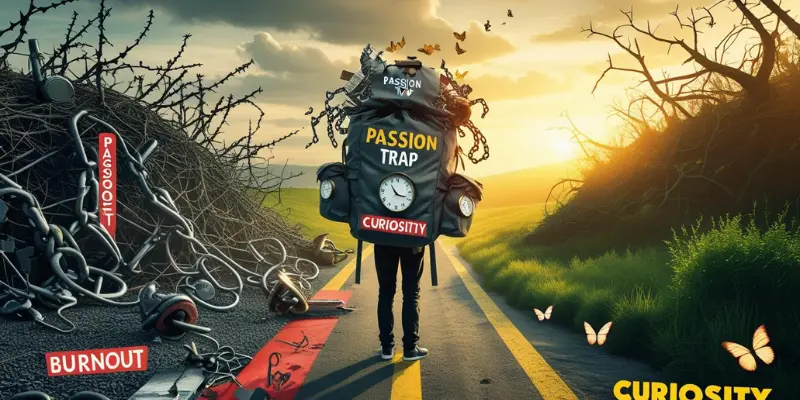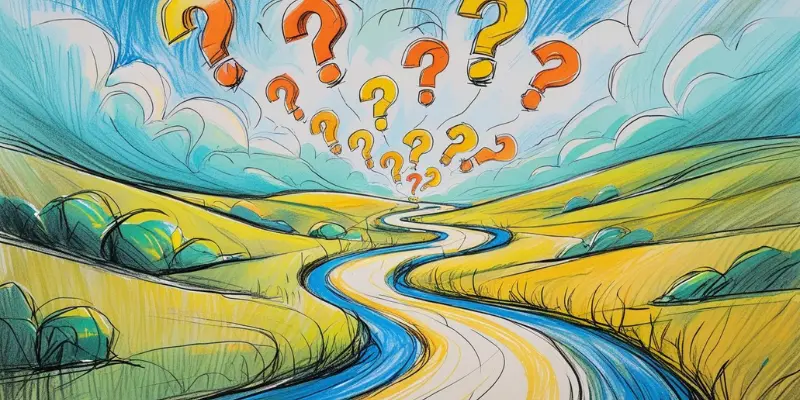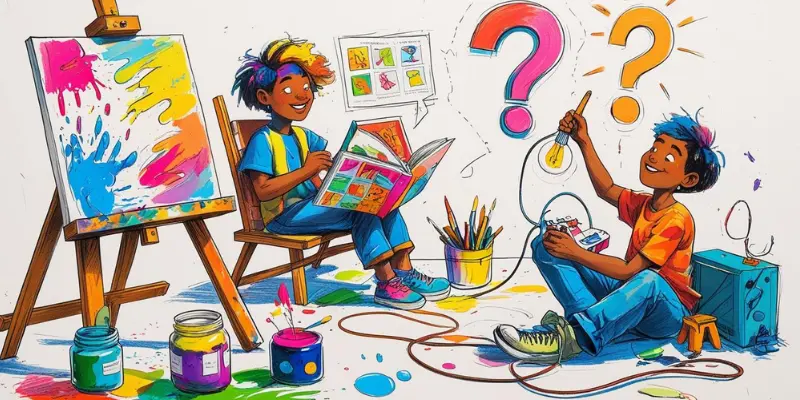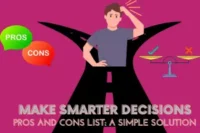The Power of a “Curiosity-Driven” Life: How to Learn and Grow for Fun
Published: 23/07/2025
Have you ever felt stuck, restless, or overwhelmed by the constant pressure to “find your passion”? It’s like you’re expected to have one all-consuming purpose that defines your life. For many of us, this quest for passion becomes a source of stress rather than inspiration. You might find yourself chasing something that seems like it should bring joy, only to realize it feels more like a burden.
Take Emma, for example. She spent years trying to “find her passion”—attending seminars, taking classes, and diving into hobbies, all in the hope of discovering that one thing that would give her life meaning. But the harder she tried, the more drained and frustrated she felt. One day, she decided to stop forcing it. Instead of chasing passion, she began following simple curiosities—things that sparked small moments of wonder. She tried painting, listened to podcasts on space, and dabbled in photography, just for fun. To her surprise, she started to feel more fulfilled than ever before, and the pressure to “find a passion” melted away.
This is where the problem lies: we’ve been conditioned to believe that passion is the only path to fulfillment. But what if passion is overrated? What if the pressure to “find it” is what’s truly holding us back?
Elizabeth Gilbert, in her book Big Magic, uses the metaphor of the “jackhammer” versus the “hummingbird” to explain why passion can often be overwhelming. The “jackhammer” represents a singular, intense drive, pounding away at one goal, while the “hummingbird” is more about lightness, exploration, and curiosity. For many, the jackhammer approach can feel exhausting, inaccessible, and even isolating. But curiosity? Curiosity is everywhere—it’s gentle, it’s inviting, and it allows for ongoing learning without the looming pressure.
In this guide, we’ll explore the power of a curiosity-driven life—a liberating, joyful, and sustainable alternative to the pursuit of passion. We’ll discuss how following your curiosity can unlock continuous learning, authentic growth, and lasting happiness, without all the pressure. You’ll walk away with actionable steps that will help you infuse curiosity into your daily routine and begin living a more fulfilling life, free from the constraints of passion.
| What You’ll Learn: |
|---|
|
So, let’s ditch the pressure and embrace the wonder. Your curiosity-driven journey starts now.
Why Curiosity Trumps Passion: A Kinder Path to Fulfillment
In today’s world, we’re constantly told that the secret to a fulfilling life is to “find your passion.” It’s a societal expectation that everyone should have one burning, all-consuming interest that defines them and drives their every decision. But here’s the reality: not everyone has a singular passion, and that’s perfectly okay. In fact, trying to force it can lead to feelings of stress, inadequacy, and burnout.
The pressure to “find your passion” often comes with a heavy weight. It can make us feel like failures if we haven’t found that one true calling. This is where the anxiety sets in—because no matter how many different things we try, none of them feel passionate enough. The feeling of “I should have something I’m passionate about by now” can be both isolating and paralyzing.

Psychological research shows that unrealistic expectations—such as the belief that we need to have a life-defining passion—can cause unnecessary stress. According to studies from the American Psychological Association, the constant pressure to meet these idealized standards often results in burnout and mental exhaustion. Instead of being liberated by our pursuits, we end up feeling trapped by the expectation of passion, leading to anxiety and dissatisfaction.
Curiosity as Your Gentle Guide: Accessible, Sustainable, Joyful
What if, instead of chasing an elusive passion, we simply follow our curiosity? Curiosity is something we all have inherently. It doesn’t require us to be certain about anything—it simply invites us to explore, to wonder, to ask “what if?” without the need for immediate answers or outcomes.
Unlike passion, which can feel like a high-pressure race, curiosity is gentle and forgiving. It’s not about achieving anything specific or meeting societal expectations. It’s about finding joy in the process of learning and discovery.
To illustrate this, let’s bring back Elizabeth Gilbert’s metaphor of the hummingbird vs. the jackhammer. While passion is often portrayed as a “jackhammer”—a singular, forceful pursuit that demands all your energy—curiosity is the “hummingbird” approach. It’s light, playful, and ever-moving, flitting from one interest to the next, without the burden of having to make it a lifelong commitment. It’s about freedom, not pressure.
The benefits of curiosity-driven exploration are clear:
- Low pressure: You don’t need to force yourself to find “the one thing” that defines you.
- High accessibility: Curiosity can be sparked by anything—a book, a conversation, a random thought. It’s available to everyone, at any time.
- Consistent engagement: With curiosity, you’re always learning, always growing. There’s no finish line, just ongoing discovery.
As Elizabeth Gilbert, who has eloquently championed this idea, advises:
Curiosity is your map. It’s your compass. It’s the thing that leads you to the next right thing to do. And it’s not as overwhelming as passion.Elizabeth Gilbert (Author of Eat Pray Love)
Unlocking Hidden Doors: The Unpredictable Rewards of Following Your Nose
One of the most exciting aspects of a curiosity-driven life is how small curiosities often lead to unexpected discoveries. Curiosity doesn’t always have a clear or predictable path, but that’s what makes it so rewarding. It’s the joy of wandering off the beaten path, not knowing where you’ll end up, but knowing you’re headed somewhere new and exciting.
Take the Post-it Note, for example. A simple experiment gone awry led to one of the most iconic office supplies in history. The invention wasn’t a result of a grand plan or obsessive passion. It was the result of a small curiosity—a scientist wondering, “What would happen if I used this weak adhesive differently?” This humble exploration led to something that changed the way we organize our thoughts and tasks.
Similarly, penicillin was discovered because of a curious moment—Alexander Fleming noticed a mold growing on a petri dish. That simple observation, driven by a willingness to explore the unexpected, transformed medicine forever.
Elizabeth Gilbert’s journey in Eat Pray Love is another perfect example of how curiosity can lead to profound personal growth. She didn’t set out with the singular goal of finding her “passion.” Instead, she followed a series of small curiosities—traveling, meditating, and learning new things along the way. These seemingly minor curiosities led her to deep, lasting change.
In both personal and professional life, embracing curiosity can open doors you never thought possible. It allows you to connect dots, explore unexpected avenues, and discover new parts of yourself without the pressure to “get it right.”
By leaning into curiosity, you unlock an entire world of possibility—one that is rich, fulfilling, and full of surprises. The journey itself becomes the reward, and every step is one of growth and discovery. So, why not let your curiosity lead the way? It’s a kinder, more joyful path to fulfillment than chasing a passion ever could be.
The Core Pillars of a Curiosity-Driven Life
Curiosity isn’t just about asking questions—it’s about creating a mindset and lifestyle that encourages constant exploration and growth. To live a curiosity-driven life, there are core pillars that guide the way. These pillars support a journey that is open, dynamic, and full of potential. Let’s break them down.
Pillar 1: Embrace the “What If?” Mindset
The first step in a curiosity-driven life is embracing the “What if?” mindset. It’s about letting go of rigid plans and being open to the possibilities that come with asking questions. Instead of sticking to a narrow path, you allow your curiosity to take the wheel.
Actionable Step: Cultivate open-mindedness by letting go of rigid plans and embracing the idea that there are countless possibilities waiting to be explored. The next time you face a challenge or opportunity, ask yourself, “What if I tried something completely different?”
Techniques: One of the best ways to nurture this mindset is through journaling curious questions. Write down anything that piques your interest, no matter how small or silly it seems. Embrace a beginner’s mind, the concept of approaching the world with fresh eyes, just as a child would. This allows you to see things in new ways and connect ideas that were previously out of reach.

I remember when I decided to try a pottery class on a whim. I had never worked with clay before, and to be honest, I wasn’t expecting to fall in love with it. But there was something deeply satisfying about molding something with my hands. That single “What if?” question led to a new hobby that gave me not only a sense of calm but also creative fulfillment. It was a reminder that curiosity doesn’t always lead to a grand discovery, but often, it leads to small joys that enrich your life.
As the brilliant physicist Richard Feynman once put it:
I have approximated myself. I am a machine, and I have learned. When I ask a question, it’s not because I am afraid of the answer. It’s because I want to know the answer.Richard P. Feynman (Nobel Prize-winning physicist)
Pillar 2: Practice Active Observation & Deep Listening
Curiosity is not just about asking questions—it’s also about being fully present and paying attention to the world around you. This is where active observation and deep listening come in. It’s about noticing the details, whether it’s how a conversation unfolds or the subtle cues in nature. It’s a practice that can help you better understand yourself, others, and the world.
Actionable Step: To practice active observation, start by paying attention to your surroundings. Go on mindful walks and notice the small things—how the air smells, the colors in the sky, or how people interact. Listen to your gut when it comes to your own feelings and instincts. This doesn’t just help you learn more about the world; it also enhances your empathy for others.
Techniques: One effective technique is asking follow-up questions in conversations. Instead of just nodding along, ask, “Can you tell me more about that?” or “What got you interested in that?” You’ll be amazed at how much deeper conversations can go when you practice active listening.
Expert Tip: Deep observation isn’t just for gathering knowledge—it’s a gateway to empathy. The more you observe the world with genuine curiosity, the better you understand people and their experiences. According to Medium, practicing mindfulness and curiosity is one of the best ways to build strong, empathetic connections. When you listen closely, you begin to notice patterns, emotions, and stories that you may have missed before.
Pillar 3: Experiment Fearlessly (Even When It’s “Pointless”)
Curiosity thrives when we give ourselves the freedom to experiment—even when the outcome seems uncertain or insignificant. The key is not to be afraid of failure. In fact, failure is often a stepping stone to new discoveries.
Actionable Step: Give yourself permission to try new things without the pressure of a specific goal. Whether it’s trying a new hobby, reading a book outside your usual genre, or experimenting with a different approach at work, it’s all about the journey, not the destination.
Techniques: Start with low-stakes experiments. Commit to something small, like learning a new skill for a week, or diving into an unfamiliar subject. These experiments might seem “pointless” at first, but the value lies in the exploration itself. Overcoming the fear of failure is essential, as curiosity is all about exploration, not perfection. Embrace the idea that every experiment, even the unsuccessful ones, provides valuable insights.

Discussion: For instance, I once spent a weekend trying my hand at coding, without any grand ambition—just the curiosity of how things worked. I had no goal to become a developer, but that curiosity led me to build my first simple website. It wasn’t perfect, but the process was exhilarating, and I gained new skills that I never anticipated.
Pillar 4: Connect the Dots & Synthesize New Ideas
Curiosity is about more than just learning—it’s about making connections between seemingly unrelated ideas. Synthesis is the ability to combine different pieces of knowledge to create something entirely new. This is where true innovation often happens.
Actionable Step: Look for patterns across different fields or disciplines. Ask yourself how unrelated curiosities might connect to create new ideas, solutions, or insights. Start by brainstorming or mind mapping ideas that come from different areas of interest and explore how they might fit together in unexpected ways.
Techniques: Engage in cross-disciplinary learning. Take a concept from one field and see how it applies to another. For example, studying psychology might inspire a new approach to marketing, or learning a language could enhance your understanding of music theory. The more you explore outside of your comfort zone, the more you’ll find ways to link ideas together.
Case Study: A classic example of connecting dots comes from Steve Jobs. When he was designing the first Macintosh, he took a calligraphy class, even though he wasn’t planning to become a calligrapher. This seemingly unrelated curiosity—about the beauty of fonts—directly influenced the Mac’s design, leading to the introduction of beautiful typography in personal computing. Jobs saw the connection between art and technology in a way that others had missed, and it led to a groundbreaking innovation.
By embracing these core pillars of curiosity, we can transform our approach to learning and personal growth. Rather than feeling pressured to find a singular passion or be perfect, we can focus on the joy of exploration. Curiosity is accessible to everyone, and by cultivating an open, experimental mindset, we open ourselves up to a life full of discovery and fulfillment. So, the next time you’re stuck or overwhelmed, remember: it’s not about passion—it’s about curiosity. Let it guide you to new places, ideas, and experiences.
Practical Steps: How to Infuse Curiosity into Your Daily Routine
Curiosity isn’t something that just happens in a vacuum—it’s a mindset you can intentionally cultivate in your day-to-day life. By infusing curiosity into your daily routine, you can unlock new opportunities for learning, growth, and joy. Here are some practical steps to help you weave curiosity into your everyday activities.
Morning Curiosity Rituals
The way you start your day can set the tone for how curious you are throughout it. Instead of jumping into your to-do list or scrolling through social media, take a moment to ignite your curiosity and open your mind to the world around you.

Actionable Step: Begin your morning with a curious question or observation. This small ritual can shift your mindset from autopilot to active exploration.
Examples:
- “What’s one new thing I can notice today?” This could be something as simple as the weather, a new idea in your morning reading, or a fresh perspective from a conversation.
- “What am I curious about right now?” Let your mind wander and see what comes up. Maybe you’re curious about how a new technology works or what happens when you try a new exercise routine.
These questions are easy to incorporate into your routine, whether it’s during your morning coffee or while getting ready for the day. By framing your day around curiosity, you prime your brain to stay open to the unexpected.
Curiosity in Your Work & Career
Curiosity doesn’t just belong in personal hobbies or leisure activities—it can be a game-changer in your professional life too. In the workplace, curiosity can drive innovation, spark problem-solving, and open doors to new career opportunities. It’s about questioning the status quo and seeking improvement.
Actionable Step: Start applying curiosity to your problem-solving and innovation at work. This means asking questions that dig deeper than the surface level.
Examples:
- “Why do we do it this way?” Questioning existing processes can often reveal inefficiencies or areas for improvement.
- “What if we tried it differently?” Taking a new approach to a task or problem can uncover better solutions.
- “How might we…?” A powerful question that invites creativity. For example, “How might we make this process more efficient?” or “How might we introduce a more sustainable practice?”
These questions can be applied in meetings, project brainstorming sessions, or even in one-on-one conversations with colleagues. A curious mindset in your career doesn’t just improve the work you’re doing—it may also help you discover new passions or opportunities you hadn’t considered before.
Fueling Curiosity Through Learning (for Fun!)
One of the most rewarding ways to nurture your curiosity is through learning—just for the sheer joy of it. Learning without pressure allows you to explore topics that excite you, without the stress of grades, deadlines, or formal goals. Curiosity-driven learning is about the process, not the outcome.
Actionable Step: Seek out new information purely for enjoyment, whether it’s through documentaries, podcasts, or quirky online courses.
Examples:
- Documentaries: Find a subject that intrigues you, whether it’s about history, technology, art, or nature. Platforms like Netflix or YouTube have endless options to fuel your curiosity.
- Podcasts: Listen to podcasts that align with your interests or introduce you to new ones. Oprah’s Super Soul Conversations, for instance, dives into insightful discussions that may spark personal curiosity.
- Online Courses: Platforms like Coursera, Udemy, or Skillshare offer courses on everything from photography to philosophy. Explore topics you’d never have thought to study—just for fun.
- Reading Non-fiction: Dive into books that expand your knowledge on a variety of subjects. Whether it’s a biography, a science book, or a piece of investigative journalism, reading outside your usual genre can be eye-opening.
Expert Tip: Approach learning without the pressure of “having to know it all” or “mastering” a subject. This mindset shift makes learning feel more like a fun discovery than a task to complete. As Albert Einstein famously said, “The important thing is not to stop questioning. Curiosity has its own reason for existing.”
Navigating Setbacks: When Curiosity Feels Stifled
Let’s face it—life gets in the way sometimes. Whether it’s lack of time, fear of failure, or external pressures, your curiosity might feel stifled at certain points. But don’t let these obstacles stop you from nurturing your inquisitive spirit. There are ways to push through the setbacks and reignite your curiosity.
Troubleshooting: Here are a few common barriers to curiosity and how to overcome them:
- Time Constraints: We’re all busy. But even with a packed schedule, you can carve out small moments for curiosity. Start by setting aside just 10-15 minutes a day to explore something new. A quick documentary, a podcast during your commute, or a short article on a random topic.
- Fear of Failure: The fear of looking foolish can stifle curiosity. But remember, curiosity is about exploration, not perfection. The more you give yourself permission to fail or be imperfect, the more freedom you’ll experience in the process. Every experiment, even the ones that don’t go as planned, provides valuable lessons.
- External Pressure: Sometimes, the pressure to “be productive” can make curiosity feel like a luxury we don’t have time for. To overcome this, protect your “curiosity time”. Set boundaries and treat your curiosity pursuits as an essential part of your well-being, just like exercise or relaxation. Remember, curiosity is a tool for personal growth, not a distraction.
Tips:
- Start small: You don’t have to dedicate hours every day. A little curiosity goes a long way.
- Remind yourself it’s “for fun”: This is key to overcoming the fear of failure. The joy comes from the journey, not the destination.
By acknowledging these setbacks and having strategies in place to navigate them, you can keep your curiosity alive no matter what challenges arise.
Infusing curiosity into your daily routine doesn’t require a massive overhaul of your life. It’s about taking small, intentional steps to cultivate a mindset that values exploration, learning, and joy. Whether it’s starting your day with a curious question, applying creative problem-solving at work, learning for fun, or navigating the occasional setback, these practical steps will help you keep curiosity at the forefront of your life. So, the next time you feel the spark of curiosity, embrace it—it’s your invitation to explore, grow, and thrive.
Expert Tips & Common Mistakes to Avoid
Cultivating curiosity is an ongoing practice—one that requires intention and mindfulness. To help you make curiosity a lasting part of your life, here are some expert tips that will guide you, along with common mistakes you’ll want to avoid.
Expert Tips for Cultivating Lasting Curiosity
Tip 1: Embrace the Small Sparks
Curiosity isn’t always sparked by big, life-changing events. Often, it starts with small sparks—those fleeting moments or minor interests that don’t seem like much at first but can lead to something much more significant. Don’t dismiss these little curiosities. Every small interest holds the potential for deeper learning and growth.
Actionable Insight: Pay attention to the small things that catch your attention, even if they seem trivial. Whether it’s a new book you’re curious about or an idea someone mentioned in passing, lean into it. These sparks can ignite a fire of discovery if you allow them to.
Tip 2: Curiosity Over Judgment
One of the biggest obstacles to curiosity is judgment. We often reject new ideas or experiences because we immediately form opinions—sometimes without giving them a fair chance. To cultivate curiosity, practice suspending judgment.
Actionable Insight: When something piques your curiosity, resist the urge to criticize or dismiss it too quickly. Instead, approach it with an open mind. Ask yourself, What’s interesting about this? What can I learn from this experience?
Tip 3: Cultivate a Questioning Mindset
The most curious people are the ones who never stop asking questions. “Why?” and “How?” are two of the most powerful tools you can use to deepen your understanding of the world around you. Make these questions a habit in your daily life.
Actionable Insight: Start by asking simple questions throughout the day. For example, “Why does this work this way?” or “How might I approach this differently?” The more you ask, the more you’ll unlock deeper layers of understanding and new possibilities.
Tip 4: Seek Diverse Perspectives
Curiosity thrives when you expose yourself to ideas and experiences that challenge your own. Engaging with people and viewpoints that are different from your own can broaden your understanding and spark new areas of interest.
Actionable Insight: Attend talks, read books from different genres, or seek out conversations with people from diverse backgrounds. The more perspectives you engage with, the more expansive and enriching your curiosity will become.
Common Mistakes That Kill Curiosity
While nurturing curiosity is relatively simple, there are a few common mistakes that can cause it to fade away. Here’s what to watch out for.
Mistake 1: Waiting for a Grand Passion
The “passion trap” often holds people back. We wait for the moment when the “perfect passion” strikes us with all its glory. But waiting for that grand, life-defining passion can stifle curiosity, leaving us stuck in inaction.
Actionable Insight: Instead of waiting for your passion to find you, embrace curiosity in the meantime. Follow the small sparks of interest that arise throughout your day. These lead to discovery and can eventually form into something meaningful, even if it’s not a grand passion.
Mistake 2: Only Pursuing “Productive” Curiosity
Sometimes, we fall into the trap of thinking that curiosity must always have a productive outcome. We feel pressured to only engage in activities that will help us grow professionally or achieve a goal. But this kind of “productive” curiosity limits our exploration.
Actionable Insight: Allow yourself to be curious for fun. Explore topics or activities that don’t have an immediate, tangible result. Watch a quirky documentary, learn about something you’ll never use again, or just follow an offbeat interest. The joy of curiosity often lies in the freedom to explore without the need for results.
Mistake 3: Fear of Looking Foolish
Curiosity is about exploration, and exploration often means trying new things where we’re not experts. The fear of looking foolish can prevent us from pursuing new ideas, learning new skills, or engaging in new experiences.
Actionable Insight: Let go of the fear of judgment. Remind yourself that curiosity is about learning, not about being perfect. Everyone starts somewhere, and the most curious people are often those who are willing to look foolish, try new things, and embrace the learning process.
Mistake 4: Isolation
Curiosity thrives in community. When we isolate ourselves, we miss out on the power of shared curiosity—learning from others, discussing new ideas, and collaborating on discoveries.
Actionable Insight: Don’t keep your curiosity to yourself. Engage with others who share your interests, or even those with different perspectives. Join clubs, online forums, or discussion groups to share ideas and grow together. Curiosity is a social experience that flourishes when shared.
Cultivating lasting curiosity isn’t just about asking the right questions or pursuing interesting activities—it’s also about avoiding the common mistakes that can derail your curiosity-driven journey. By embracing small sparks of interest, suspending judgment, developing a questioning mindset, and seeking out diverse perspectives, you’ll keep your curiosity alive and thriving. Just remember, curiosity isn’t a destination—it’s a lifelong process of discovery. Embrace it fully, and you’ll open up a world of endless learning and personal growth.
Conclusion: Your Joyful Journey Starts Now
As we wrap up, let’s take a moment to reflect on the key takeaways from embracing a curiosity-driven life. By shifting away from the pressure to find one grand passion and instead following your natural curiosity, you open yourself up to a world of continuous growth, genuine fulfillment, and unlimited joy.
- Less Pressure: Curiosity allows you to explore without the burden of having to “get it right.” There’s no pressure to perfect or master anything—just a continual journey of learning.
- More Joy: By embracing the small sparks of interest around you, life becomes more enjoyable. Curiosity invites fun, spontaneity, and surprise into your daily routine.
- Continuous Growth: Every curious step you take leads to new knowledge, perspectives, and experiences. Curiosity fosters lifelong learning that evolves with you.
- Genuine Fulfillment: Curiosity connects you to the things that truly matter, whether through personal discovery or meaningful connections with others.
And the best part? Curiosity is accessible to everyone, no matter your age, background, or where you are in life. You don’t need a “passion” to start living a fulfilling life—you just need a curious mind and an open heart.
So, what are you waiting for? Your curiosity-driven journey starts now.
Take that first small step today. Ask yourself, “What’s one tiny curiosity I’ll explore today?” It doesn’t have to be big or life-changing—it just needs to spark that first moment of discovery.
We’d love to hear about your curiosity journey! Share your initial curious steps in the comments below or on social media using the hashtag #CuriosityUnlocked. What’s something new you’re exploring today? Let’s inspire each other to continue on this joyful, curiosity-driven path. Your discoveries are waiting!
Still Curious? Your Curiosity-Driven Life Questions Answered
Living a curiosity-driven life means exploring new interests without the pressure to “find your passion.” It’s about asking questions, staying open to learning, and embracing new experiences for the joy of discovery.
Start by asking small questions every day, like “What’s something new I can notice today?” Make time for exploring new hobbies, reading, or watching something different from your usual routine.
What if?” challenges the status quo and opens up possibilities for new experiences. It helps you approach situations with an open mind, leading to innovative thinking and unexpected discoveries.
Yes! Curiosity is a more accessible, sustainable approach. Unlike passion, which can feel overwhelming or limiting, curiosity is about exploring interests and learning without pressure, leading to ongoing growth and fulfillment.
Not at all! Curiosity is a universal trait. It’s about asking questions and exploring ideas—something anyone can cultivate, regardless of their creative background.
Curiosity encourages mindfulness, reduces stress, and promotes a growth mindset. By focusing on exploration and learning, curiosity helps you stay engaged and positive, improving overall well-being.
Absolutely not! Curiosity is ageless. No matter your age, it’s never too late to start exploring new interests, learning new skills, or embracing different perspectives.
Small questions often lead to unexpected insights. Just like how Post-it Notes and penicillin were discovered by accident, following minor curiosities can lead to major breakthroughs.

- Be Respectful
- Stay Relevant
- Stay Positive
- True Feedback
- Encourage Discussion
- Avoid Spamming
- No Fake News
- Don't Copy-Paste
- No Personal Attacks



- Be Respectful
- Stay Relevant
- Stay Positive
- True Feedback
- Encourage Discussion
- Avoid Spamming
- No Fake News
- Don't Copy-Paste
- No Personal Attacks




